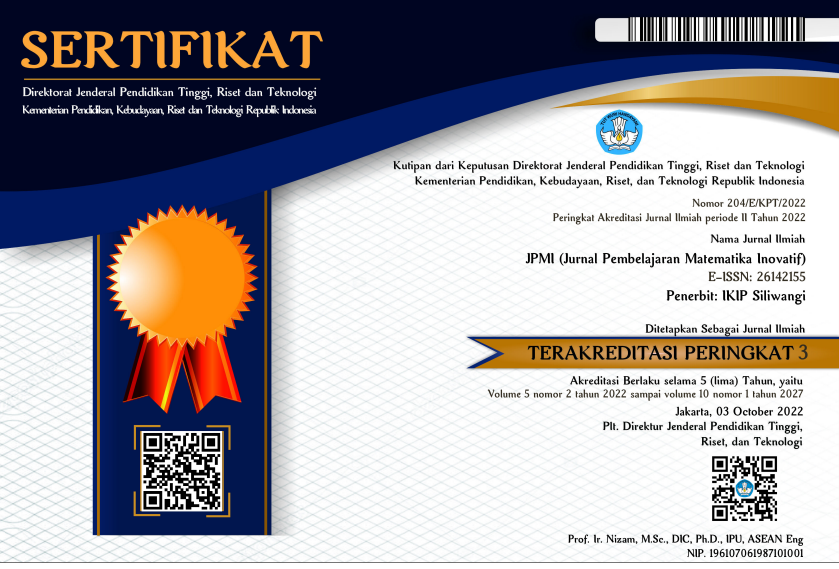Pemberian scaffolding dalam pemecahan masalah matematis siswa SMP
DOI:
https://doi.org/10.22460/jpmi.v6i4.17923Keywords:
Scaffolding, Problem solvingAbstract
This study aims to observe students' systematic problem solving by applying scaffolding. Providing a framework plays an important role for students who struggle to solve problems in the system of linear equations of two variables. The research subjects were Jambi Junior High School VIII grade students as many as two students. The research method used is descriptive qualitative method applied in the research process with data collected through Polya's problem solving description test two questions with unstructured interviews. Two students who solve problems in the form of descriptions begin to plan solutions to problems that are analyzed in general. So, the framework that can be given consists of description, structuring, and validation. Errors in problem solving can be addressed by observing the understanding of the problem, planning the solution, implementing the solution plan, and checking back.
References
Albay, E. M. (2019). Analyzing the effects of the problem solving approach to the performance and attitude of first year university students. Social Sciences & Humanities Open, 1(1),
Anghileri, J. (2006). Scaffolding practices that enhance mathematics learning. Journal of Mathematics Teacher Education, 9, 33–52.
Arofah, M. N., & Noordyana, M. A. (2021). Kemampuan pemecahan masalah matematis ditinjau dari kemandirian belajar siswa pada materi lingkaran di Kelurahan Muarasanding. Plusminus: Jurnal Pendidikan Matematika, 1(3), 421–434.
Bakker, A. (2018). Design research in education: A practical guide for early career researchers. Routledge.
Budi, B. S., Nusantara, T. N., Subanji, S. S., & Susiswo, S. S. (2020). Analisis kesalahan newman siswa dalam menyelesaikan soal nilai mutlak dan scaffolding-nya. Jurnal Pendidikan Matematika Undiksha, 11(2).
Byrne, M., Hanusch, S., Moore, R. C., & Fukawa-Connelly, T. (2018). Student interpretations of written comments on graded proofs. International Journal of Research in Undergraduate Mathematics Education, 4, 228–253.
Chapman, O. (2015). Mathematics teachers’ knowledge for teaching problem solving. LUMAT: International Journal on Math, Science and Technology Education, 3(1), 19–36.
Ejersbo, L. R., & Leron, U. (2005). The didactical transposition of didactical ideas: The case of the virtual monologue. Working Group 11: Different Theoretical Perspectives and Approaches in Research in Mathematics Education, 1379.
Eko, Y. S., Prabawanto, S., & Jupri, A. (2018). The role of writing justification in mathematics concept: the case of trigonometry. Journal of Physics: Conference Series, 1097(1), 12146.
Evans, C. W., Leija, A. J., & Falkner, T. R. (2001). Math links: Teaching the NCTM 2000 standards through children’s literature. Libraries Unlimited.
Greene, R. W. (2018). Transforming school discipline: Shifting from power and control to collaboration and problem solving. Childhood Education, 94(4), 22–27.
Hasan, B. (2020). Kesulitan Siswa dan Scaffolding dalam Menyelesaikan Masalah Geometri Ruang. Numeracy, 7(1), 49–64.
Huda, N., & Kencana, A. G. (2013). Analisis kesulitan siswa berdasarkan kemampuan pemahaman dalam menyelesaikan soal cerita pada materi kubus dan balok di kelas VIII SMP Negeri 30 Muaro Jambi. Prosiding Semirata 2013, 1(1).
Irfan, M., Nusantara, T., Subanji, S., & Sisworo, S. (2018). Why did the students make mistakes in solving direct and inverse proportion problem? International Journal of Insights for Mathematics Teaching (IJOIMT), 1(1), 25–34.
Kurniasari, C., Hidajat, D., & Handayani, Y. A. (2022). Analisis kesulitan menyelesaikan soal cerita materi barisan dan deret aritmetika dengan indikator polya pada siswa kelas X. Numeracy, 9(2), 122–137.
Lestari, A. B., & Afriansyah, E. A. (2021). Kemampuan pemecahan masalah matematis siswa SMP di kampung cibogo pada materi SPLDV. SIGMA: Jurnal Pendidikan Matematika, 13(2), 92–102.
Lithner, J. (2000). Mathematical reasoning in task solving. Educational Studies in Mathematics, 165–190.
Maspupah, A., & Purnama, A. (2020). Analisis kesulitan siswa mts kelas viii dalam menyelesaikan soal cerita sistem persamaan linear dua variabel (spldv) ditinjau dari perbedaan gender. Jurnal Cendekia: Jurnal Pendidikan Matematika, 4(1), 237–246.
Pape, S. J. (2004). Middle school children’s problem-solving behavior: A cognitive analysis from a reading comprehension perspective. Journal for Research in Mathematics Education, 35(3), 187–219.
Priyati, P., & Mampouw, H. L. (2018). Pemberian scaffolding untuk siswa yang mengalami kesalahan dalam menggambar grafik fungsi kuadrat. JTAM (Jurnal Teori Dan Aplikasi Matematika), 2(1), 87–95.
Raharti, A. D., & Yunianta, T. N. H. (2020). Identifikasi kesalahan matematika siswa SMP berdasarkan tahapan kastolan. Journal of Honai Math, 3(1), 77–100.
Subanji, S. (2013). Proses berpikir pseudo siswa dalam menyelesaikan masalah proporsi. J-Teqip, 4(2), 207–226.
Subanji, S. (2016). Teori berpikir pseudo penalaran kovariasional. Malang: Penerbit Universitas Negeri Malang.
Sulistiowati, D. L., Herman, T., & Jupri, A. (2019). Student difficulties in solving geometry problem based on Van Hiele thinking level. Journal of Physics: Conference Series, 1157(4), 42118.
Susanti, M. (2016). Perancangan sistem informasi akademik berbasis web pada SMK Pasar Minggu Jakarta. Jurnal Informatika, 3(1).
Susilawati, W. (2015). Belajar dan pembelajaran matematika. CV Insan Mandiri.
Szabo, A., & Andrews, P. (2018). Uncovering the relationship between mathematical ability and problem solving performance of swedish upper secondary school students. Scandinavian Journal of Educational Research, 62(4), 555–569.
Tyaningsih, R. Y., Novitasari, D., Hamdani, D., Handayani, A. D., & Samijo, S. (2020). Pemberian Scaffolding terhadap berpikir pseudo penalaran siswa dalam mengkonstruksi grafik fungsi. Journal of Science and Education (JSE), 1(1), 20–31.
Vinner, S. (1997). The pseudo-conceptual and the pseudo-analytical thought processes in mathematics learning. Educational Studies in Mathematics, 34(2), 97–129.
Yuwono, T., Supanggih, M., & Ferdiani, R. D. (2018). Analisis kemampuan pemecahan masalah matematika dalam menyelesaikan soal cerita berdasarkan prosedur Polya. Jurnal Tadris Matematika, 1(2), 137–144.
Downloads
Published
Issue
Section
License
Copyright (c) 2023 JPMI (Jurnal Pembelajaran Matematika Inovatif)

This work is licensed under a Creative Commons Attribution-ShareAlike 4.0 International License.
The author is responsible for acquiring the permission(s) to reproduce any copyrighted figures, tables, data, or text that are being used in the submitted paper. Authors should note that text quotations of more than 250 words from a published or copyrighted work will require grant of permission from the original publisher to reprint. The written permission letter(s) must be submitted together with the manuscript.
















